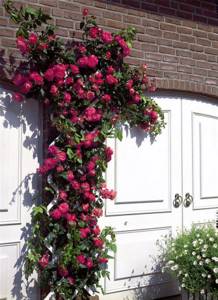Purpose and methods of vertical gardening
One of the techniques of landscape design is vertical gardening, with the help of which the space acquires depth and perspective, becomes interesting and unique.
Vertical gardening has not only a decorative purpose, but also a completely practical one. Having even a very small area at your disposal, it is possible to place an additional number of your favorite plants, as well as hide unpresentable outbuildings or the view behind the fence.
The leader in vertical gardening is, of course, the climbing rose.
Its long graceful branches, strewn with luxurious flowers, will perfectly cope with the decoration of the walls of the gazebo in the relaxation corner, and will decorate the unsightly wall of the house and other buildings.
Climbing roses are an excellent option for creating decorative columns and pyramids. They go well with small architectural forms, and planted along the fence, such roses will protect the garden from prying eyes and create an incredible atmosphere!
Climbing roses do not have tendrils with which they could cling to supports and cannot wrap around the supports themselves, so they need to be tied up.
If you don’t help the climbing rose to attach to the support, it will simply creep along the ground; by the way, in this form it is also used in landscape design as a ground cover. This method of using climbing roses helps to hide defects and unevenness in the landscape, as well as all kinds of hatches and communications.
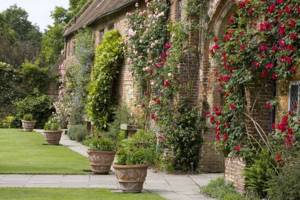
Roses in landscape design
Climbing roses are not quite vines, although they climb. They cling to support with their spikes. Arches, gazebos, and columns can be used as support. Plants on natural supports, such as trees in the garden, look good. Broom, rowan, and yew are often used. Having wrapped her lashes around a tree trunk, the queen holds herself perfectly, creating a unique picture.
Attention! If the root system of the tree is almost on the surface, rose bushes cannot be planted.
Branches will subsequently form on each stem, on which fragrant buds will then bloom magnificently. Supports can have different shapes and sizes. Flower growers must choose the desired direction for the lashes. To decorate a house or balcony, bushes are planted at a distance of 45 from the wall.
After the shoots appear, they are directed in the right direction. Some of the lashes are tied horizontally, and the rest grow upward
This formation of a bush of climbing varieties is important for landscape design. With the help of rose bushes you can decorate the walls of houses and fences. Even the old fence is transformed, covered with bright, fragrant flowers. Look at the options in the photo.
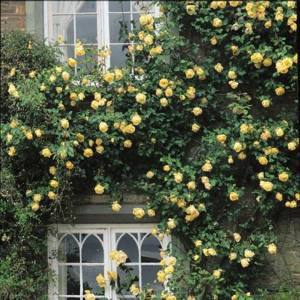
Why not Monomakh's hat over the entrance to the house made of pink buds.
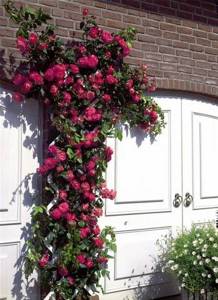
Supports for climbing roses
There are many types of supports for climbing plants. Many of them look attractive and decorative even in winter.
So, if you have placed your beauty in the center of the flower garden, a support of a beautiful graceful shape , which itself will serve as decoration while the rose is under cover in winter.
The umbrella-shaped support looks unusual When the roses reach the top, their shoots will cascade down, creating an unusual garden structure.
garden sculptures and statues and forged elements are often used as a support for climbing roses are often used to support climbing roses . They can be different: from simple lattice panels of regular geometric shapes to exquisite ones consisting of carved figured panels with spiers and scrolls. The trellis can be stationary or portable.
For a stationary trellis, the support pillars, to which the panels are then attached, are dug to a depth of at least 60 - 70 cm, and for the reliability of the structure they are secured with concrete.
A portable trellis can be placed in any corner of the garden, its location can be changed, which allows you to decorate the same space in different ways.

In order to attractively design the gazebo and its alley, decorate the front entrance, and also separate one area of the site from another, landscape designers use pergolas and arches.
Pergolas are several pillars with cross beams or several arches above the path, connected to each other, from which a green tunnel is obtained. A pergola entwined with climbing roses provides shade and coolness. The pergola arch can be semicircular or rectangular.
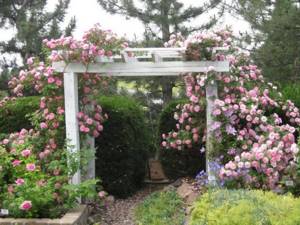
An arch is a multifunctional structure in garden design that serves as a passage from one garden area to another. Several arches arranged in a row form a blooming, luxurious arcade.
For comfortable movement, pergolas and arches must have sufficient width and height. The height should be at least 2.5 m, and the width should allow you to easily walk or stand under the pergola.
Arches or pergolas entwined with climbing roses and gazebos surrounded by them give the garden a new breath and special romance. Arches and obelisks made of metal give the garden visual airiness, special charm and make it more comfortable.
Pergolas and trellises made of wood or metal give the garden a certain southern flavor with a special charm and dreams of the sea and wanderings. The greatest effect can be achieved by planting (at a distance of at least 60 cm) different varieties of roses near each side of the arch, which would be harmoniously combined in shade and have flowers of different sizes.
Choose varieties of roses with elastic, well-bending vines. Intertwining over time, climbing roses of different varieties form a single lush bush with flowers of different colors and sizes. The use of re-blooming varieties of roses will prolong the decorativeness and elegance of arches and pergolas.

Color combinations
The combination of any of the colors of climbing roses with a white rose looks very colorful and bright. Its white flowers will add freshness and solemnity to such a composition.
To create a composition of continuous flowering, it is necessary to select climbing roses with different terms and duration of flowering, harmonizing in color. For the same purpose, other climbing plants, such as clematis and princelings, are often planted next to climbing roses.
When designing a plot, it is important not only to properly plan the territory, but also to select varieties of roses that will decorate the garden and will delight you with a variety of colors and flower shapes, abundant and long-lasting flowering, and a pleasant and healing aroma.
You can learn more about ways to organize a rosary here.
When decorating a romantic garden, it is better to use climbing roses of creamy pink, light yellow or pale pink color.
This color scheme will relax and give peace. A garden that lifts your spirits should be bright, cheerful and festive even in cloudy weather.
Many roses of bright red, orange, hot pink, bright crimson, yellow, golden, reddish-yellow variegated, striped colors are usually planted in it. If such a riot of colors is still too bright for you, then this color scheme can be harmonized and balanced by planting several varieties of white roses.
Combination with other plants
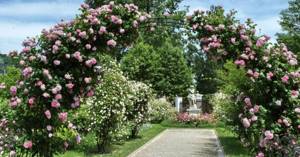
Beauty Rose is very selective about her “companions.” To create a harmonious and decent flower bed, it is important to select all the plants correctly. It is important that other garden participants do not distract attention from the blooming aristocrat. Neighborhood with other crops has a lot of attention on the rose, not only from an aesthetic point of view, but also from an agricultural one. Rose, thanks to genetics, is a long-liver. And so that nothing interferes with this, it must be correctly combined with other garden plantings.
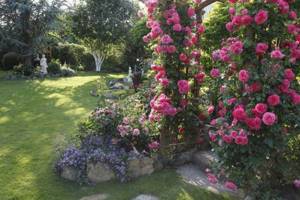
Creepers will help roses create a beautiful cozy corner. They are as beautiful and showy as the climbing queen of the garden, and their flowers go well with pink buds. Lianas, like roses, grow very quickly. Such a tandem will delight the owners of the site with its sophistication in the spring. The combination of a rose and a vine will help protect the garden not only from prying eyes, but also from noise, dust, and drafts. Invading the gazebo, these plants create a real blooming waterfall.
A special color is created by the duet of climbing roses and lemongrass. Its resemblance to a vine and delicious fruits add originality to the rose, and reveal it from a completely different side.
How to plant roses correctly?
Landscape design specialists advise planting climbing varieties at a distance of 50-60 cm from the support, support trellises, and arches.
If the support has a concrete base, it is necessary to prevent the rose roots from coming into contact with it to avoid freezing in winter. All roses, including climbing ones, prefer a warm and sunny southern exposure and do not tolerate stagnant water at the roots.
It is advisable to cover the bushes from northern winds. When planting, the lashes are cut to 30-35 cm and the roots are shortened slightly to bring the above-ground and underground parts into line. When planting climbing roses, it is necessary to provide a place where you can lay their vines for shelter for the winter.
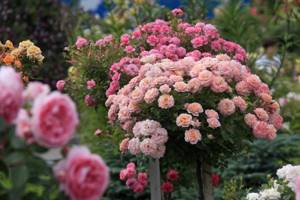
Which location is best for climbing roses?
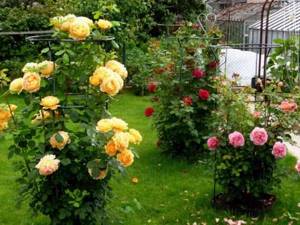
Ornamental plants love bright sunlight. It is advisable that the area be ventilated. The plant develops well if roses have not been planted in the area before. Note!
Groundwater negatively affects plant development. The site must have at least a minimum slope. For planting roses, choose places on a hill.
Sometimes roses are planted next to the walls of a building. This leads to depletion of the plant's roots. To prevent trouble, it is recommended to maintain a distance of 60 centimeters from the wall, 50 from other flowers.
Climbing roses need support. They are often used for arches, fences, nets, and walls.
Sheltering roses for the winter
During the summer period, the climbing rose grows lashes 2-3.5 m long, depending on the characteristics of the variety and care of the plant. With the onset of frost, roses are removed from their supports and placed on spruce branches (spruce branches).
The top is also covered with spruce branches and non-woven breathable material. You should not use film for covering, as during thaws the roses will suffer from damping off. In the spring of next year, only the frozen and frosted shoots and the ends of the shoots on the strong outer bud are pruned.
The shoots that survived after overwintering are first spread on the ground so that strong replacement shoots develop at the base of the bush, ensuring flowering of the bush the next year. After the young replacement shoots reach a length of 50-70 cm, the old shoots on which flowering should occur this year are tied to supports.
If climbing roses overwinter on supports, they are wrapped in non-woven covering material and remain in this form until spring.
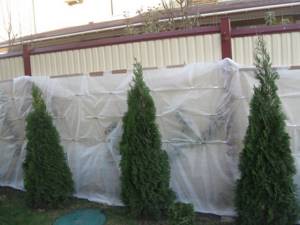
Important!
Let us highlight the points that you need to pay attention to when decorating the landscape with climbing roses:
- the dimensions of all garden structures must correspond to the size of the house and garden
- keep the proportions
- erected arches and pergolas, trellises and other supports must be strong and well secured
- for a successful design and long-lasting effect, take into account the plants’ requirements for fertility, water and air permeability of the soil, watering regime and lighting
- a stylish garden is not a huge number of roses planted according to the principle “the more the better,” but the most decorative combination of them.
